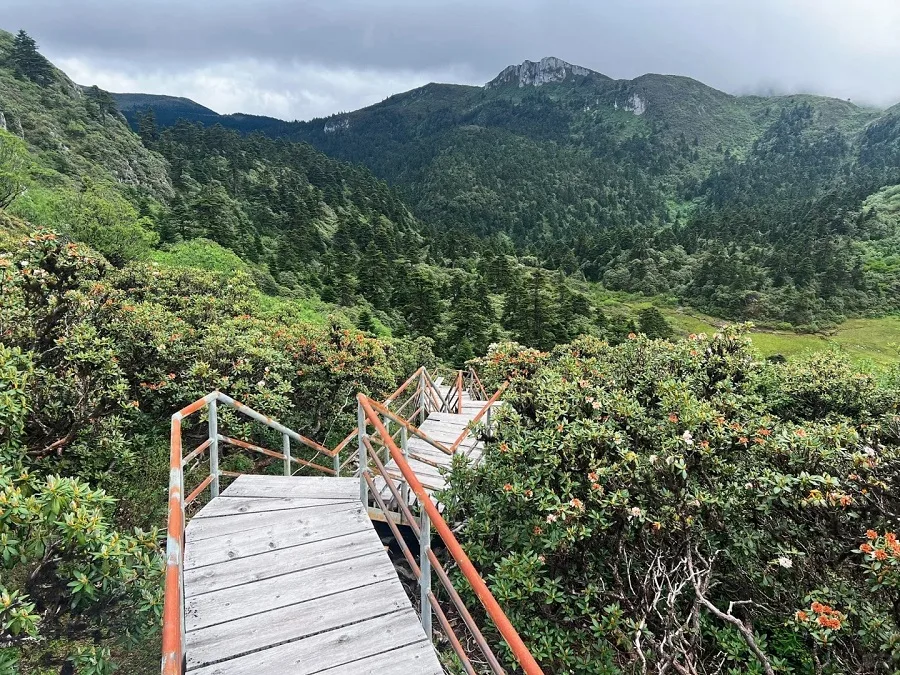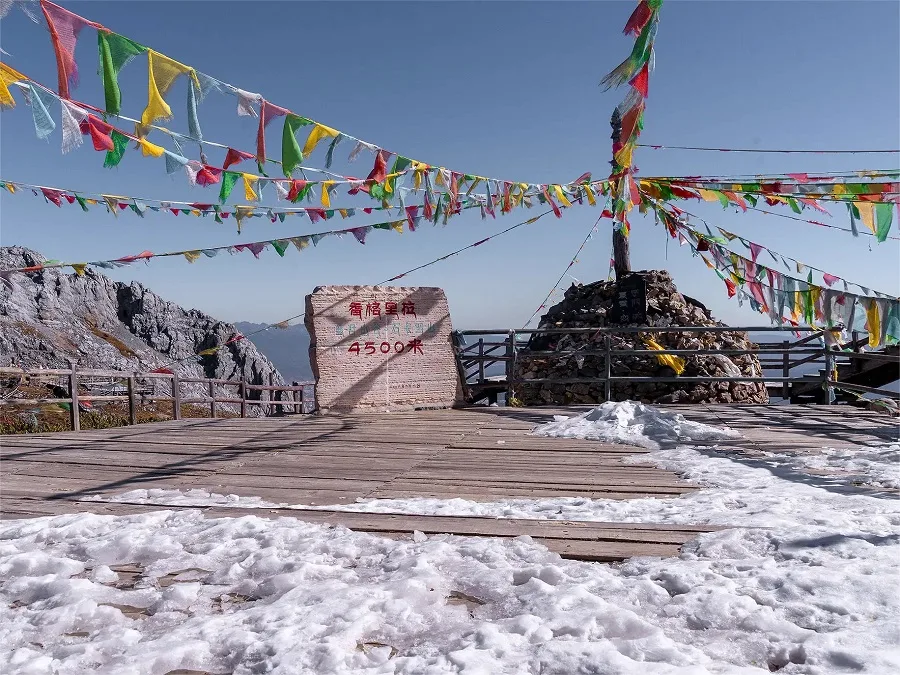Shika Snow Mountain (石卡雪山), located southwest of Jiantang Town in Shangri-La County, stands at an altitude of 4,449.5 meters and is a seasonal snow-capped mountain. The name “Shika” is derived from Tibetan, meaning “Mountain of Deer.” In Tibetan Buddhism, deer symbolize the multitude of beings listening to the Buddha’s teachings, thus Shika Snow Mountain represents “auspicious longevity and righteousness against evil.”
Historically, Shika Mountain served as a crucial link between the Tubo Kingdom and Nanzhao. It was the first sacred mountain on the Ancient Tea Horse Road entering the Tibetan regions during the Tubo period. This mountain facilitated harmonious relations and mutual benefits between Tubo and Nanzhao, fostering the union between the Nanzhao princess and the Tubo king.
Although called a snow mountain, Shika is snow-capped only from November to April or May each year. During the rest of the year, its rocky landscape is exposed, while the lower slopes are covered with lush meadows and blooming rhododendrons. This diverse scenery makes it a delightful place to explore, offering visitors the chance to enjoy the beautiful alpine meadows and vibrant flowers during the warmer months.
Table of Contents
- Basic Information
- Location and Transportation
- Seasonal Beauty of Shika Snow Mountain
- Travel Arrangements
- Attractions near Shika Snow Mountain
Basic Information
| Estimated Length of Tour | 1 day |
| Ticket Price | 160 RMB (including admission and cable car) |
| Opening Hours | 8.00 – 16.00 |
| Telephone Number | 0086-0887-8232565 |
Location and Transportation
Shika Snow Mountain is situated in the southwestern part of Jiantang Town, Shangri-La County, Yunnan Province, on the southeastern edge of the Qinghai-Tibet Plateau. It is approximately 7.34 kilometers away from the county seat and stands as one of the closest comprehensive tourist attractions to Shangri-La Airport within the Diqing Tibetan Autonomous Prefecture.
Take the Free Shuttle Bus: There’s a free shuttle bus available at the entrance of Xinhua Hotel in Shangri-La County (opposite the former sports stadium). These buses run at regular intervals every day and can take you directly to the Shika Snow Mountain scenic area.
Charter a Vehicle: You can also charter a vehicle from Shangri-La County to Shika Snow Mountain. The round-trip cost is approximately 50 to 60 yuan. This option allows for a more flexible itinerary tailored to your preferences, and the driver can stop for photo opportunities at your desired locations along the way.
Seasonal Beauty of Shika Snow Mountain

Spring: Spring arrives late on the high plateau of Shika Snow Mountain. By May, while the summit remains blanketed in snow, the lower valleys begin to transform into a lush green carpet. The landscape is dotted with grazing cattle and sheep, creating a picturesque scene. The clear blue sky, white clouds, snow-capped peaks, verdant meadows, traditional Tibetan houses, and wisps of smoke from chimneys all come together to form a harmonious tableau, presenting a breathtaking view of nature’s perfection.
Summer: Summer is the season of blooming flowers at Shika Snow Mountain. The hillsides are initially covered with vibrant rhododendrons, followed by a spectacular array of herbaceous flowers. Yellow primroses and spurge laurels, red Chinese alpine lilies and Shangri-La alpine flowers, blue irises, and various species of poppies paint the landscape with a riot of colors. From June to August, the subalpine meadows of places like Jiasheng Pasture are taken over by flowers like the leaf-like Ligularia and various species of Pedicularis, with the shores of glacial lakes adorned with the ornamental Rheum nobile. The alpine meadows at the summit become a domain of unique dwarf flowers, making the mountain a paradise of floral diversity in the summer months.

Autumn: In September, as Napa Meadow turns into a sea of red thanks to the extensive growth of spurge, Shika Snow Mountain itself becomes a golden world. Large groves of red fir and birch trees transform the landscape with their autumnal hues. It seems as though nature, celebrating the harvest season, has intentionally adorned Shika Snow Mountain with a golden crown and Napa Meadow with a red cloak, symbolizing a time of abundance and preparing for the upcoming winter. This golden and red scenery creates an ethereal atmosphere, attracting visitors to witness the beauty of autumn in its full glory.
Winter: Winter brings snowfall, turning Shika Snow Mountain into a dreamlike wonderland. Under the clear blue sky, the mountain’s snowy peaks, white meadows, and traditional Tibetan houses all contribute to a serene and magical landscape. The blanket of snow creates a pristine environment, evoking a sense of purity and tranquility.
Travel Arrangements

Traveling to Shika Snow Mountain is made convenient and accessible through a well-organized cable car system that takes visitors effortlessly to the top, providing stunning views and a comfortable journey. The entire trip via the cable cars typically takes around 3-4 hours round trip, depending on how much time you spend at each stop and your personal pace.
First Segment – Yalaqingbo Pasture: The journey begins with the first cable car ride that takes you to the Yalaqingbo Pasture, situated at an elevation of 3,764 meters. This segment of the ride offers breathtaking views and a refreshing experience as you breathe in the crisp, clean air of the highlands. At the pasture, you can explore the surrounding area, enjoy the serene landscape, and take in the invigorating atmosphere of the Tibetan plateau.
Second Segment – Summit: After enjoying the Yalaqingbo Pasture, you head back to the cable car station to continue your ascent to the mountain’s summit. The second cable car ride takes you to the top, where you will find the summit viewing platform. From this vantage point, you can see a panoramic view of several majestic snow-capped peaks, including Biluo Snow Mountain, Meili Snow Mountain, the three sacred mountains of Yading, Haba Snow Mountain, and Jade Dragon Snow Mountain. The best time to enjoy this spectacular mountain scenery is from November to the following March or April.





